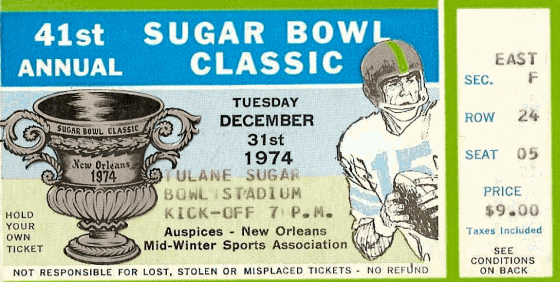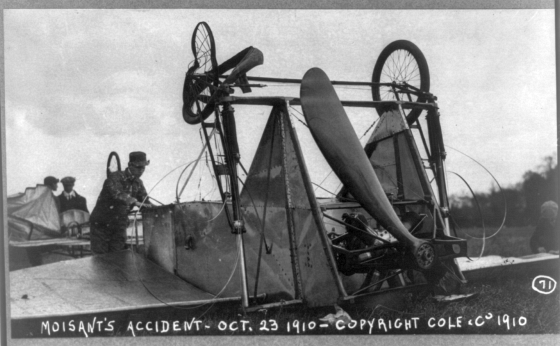|
Today in New Orleans History |
|
|
December 31


 New Orleans-Item sports editor Fred Digby popularized
the term "Sugar Bowl" in 1927. The first Sugar Bowl game was played there on January 1, 1935, against the Philadelphia
Temple Owls. The last Sugar Bowl game in Tulane Stadium was played on December 31, 1974 when Nebraska beat
Florida 14-10. The stadium was condemned in 1975. Upon appeal by the university, the
original concrete and brick section was deemed fit to use, but the newer metal seating section was declared unfit. The last game ever played in Tulane Stadium was between De La Salle and Rummel on November
1, 1979. The last point scored in Tulane Stadium history was by Rummel High place kicker
Gary Boudreaux. The stadium was under demolition from November 18, 1979
through June 15, 1980.
 

And You won't pay a penny more! To receive an update for each day in New Orleans history,
join our facebook page - Today in New
Orleans History
On December
31, 1978 the Marshall Tucker Band, Firefall, and Jay Boy Adams performed at A Warehouse.
On December
31, 1976, Styx and Hot Sauce performed at A Warehouse. On December 31, 1975, Atlanta Rhythm Section and Hydra performed
at A Warehouse.
The Allman Bros., R.E.O. Speedwagon, and Vince Vance & Valiants performed at A Warehouse
on December 31, 1971. The Allman Brothers Band and Dr.
John the Night Tripper performed at A Warehouse on December 31, 1970. For several generations in Bucktown and West End history the Bruning family was known and loved
for their volunteer efforts to save lives along the shores they called home. When Theodore Bruning III died in 1914 of typhoid
malaria the headline included “He saved others, himself he could not save”. The article included the fact that
“father, son , and grandson, all with the same name “Theodore” and John C. have been heroic life savors
in Lake Pontchartrain for years”. When Captain John Charles Bruning died at age 91 on December 31, 1963
the news appeared on the front page of the Times-Picayune, noting his 20 plus years of service on the Jefferson Parish School
Board, the one-day closing of the schools in his memory, and the many lives he and his family had saved through the years.
These quite heroics (they did not accept monetary thanks and seldom acknowledged awards) began in 1859 when several restaurants
were opened along the shoreline near the 17th Street Canal. In that year Theodore Bruning moved his Carrollton restaurant
to Bucktown/East End. In 1882 he leased no.16, Revetment Levee, West End from the city of New Orleans for $150 per year.
His son continued the restaurant business and his grandsons opened a boathouse and fishing supply business. A storm destroyed
the restaurant which was rebuilt on the Jefferson Parish side of the peninsula which jutted out past the canal. The Original
Bruning’s Restaurant which, for a time, featured dancing waitresses and rows of slot machines operated over the lake
until Hurricane Georges badly damaged it in 1998. The restaurant moved to Federico's on-land building next door where Bruning’s
served seafood until Hurricane Katrina decimated the area. Bruning's was the third oldest restaurant in New Orleans; only
Antoine's and Tujaques pre-dated it. In 1893 Captain John C. Bruning built the landmark family home which was also washed
away in Hurricane Katrina. December 31, 1955 Photo of the NORD team which won the Santa Bowl.
Moisant Dies in Crash Near New Orleans |
|
|

To receive an update for each day in New Orleans history,
join our facebook page - Today in New
Orleans History.
Analytics |

 On New Year's Eve, 1910, John Bevins Moisant competed with four pilots for the $4,000 Michelin Prize
to beat the sustained flight record of 362.66 miles. He flew from City Park headed for the competition's
start field in Harahan. After circling three times at 200 feet, wind shear at twenty-five feet
caused the plane to crash as he attempted to land. Scientific American magazine reported
that he was the first aviator to be thrown from a plane in a. fatal accident. In 1946, the city
named its new airport in Kenner
On New Year's Eve, 1910, John Bevins Moisant competed with four pilots for the $4,000 Michelin Prize
to beat the sustained flight record of 362.66 miles. He flew from City Park headed for the competition's
start field in Harahan. After circling three times at 200 feet, wind shear at twenty-five feet
caused the plane to crash as he attempted to land. Scientific American magazine reported
that he was the first aviator to be thrown from a plane in a. fatal accident. In 1946, the city
named its new airport in Kenner 
